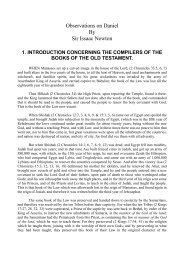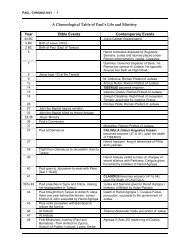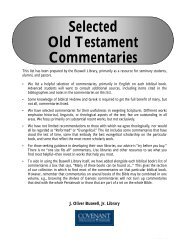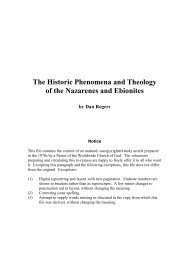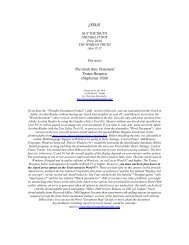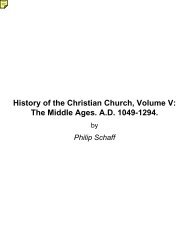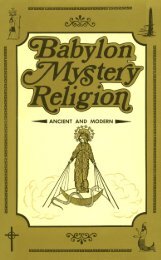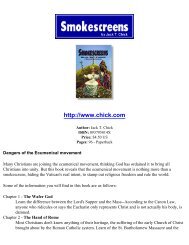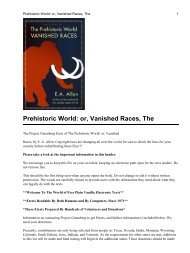Legends of the Shawangunk2 JR.pdf - Friends of the Sabbath ...
Legends of the Shawangunk2 JR.pdf - Friends of the Sabbath ...
Legends of the Shawangunk2 JR.pdf - Friends of the Sabbath ...
Create successful ePaper yourself
Turn your PDF publications into a flip-book with our unique Google optimized e-Paper software.
128 <strong>Legends</strong> <strong>of</strong> <strong>the</strong> Shawangunk.<br />
mud, homesick and heartsick, and doubtless contrasting <strong>the</strong> wilds <strong>of</strong> Sullivan with <strong>the</strong><br />
pleasant home <strong>the</strong>y had left in <strong>the</strong> land <strong>of</strong> plenty and comfort.<br />
The next day <strong>the</strong> floods subsided so that Mr. Hoyt mounted on one <strong>of</strong> his horses,<br />
crossed <strong>the</strong> kill, and went in search <strong>of</strong> assistance. At <strong>the</strong> west side <strong>of</strong> <strong>the</strong> Mamakating<br />
valley an enterprising individual had opened a log tavern. Here Mr. Hoyt obtained an<br />
extra team, with which he returned to his family. With <strong>the</strong> united efforts <strong>of</strong> <strong>the</strong> three<br />
strong teams <strong>the</strong> cart was safely brought over <strong>the</strong> stream. That night <strong>the</strong> family found<br />
more comfortable quarters in <strong>the</strong> log tavern.<br />
When <strong>the</strong>y reached <strong>the</strong> vicinity <strong>of</strong> <strong>the</strong>ir new home on <strong>the</strong> east bank <strong>of</strong> <strong>the</strong> Neversink,<br />
Mr. Hoyt learned that <strong>the</strong> cabin he had built was untenable; <strong>the</strong> snow <strong>of</strong> <strong>the</strong> previous<br />
winter had broken down its bark ro<strong>of</strong>, and it was little better than a ruin. The settlers<br />
informed him <strong>the</strong>re was a small log structure on <strong>the</strong> opposite bank <strong>of</strong> <strong>the</strong> Neversink that<br />
had been used as a school-house, but was at that time vacant. Into this he moved his<br />
family until he could build ano<strong>the</strong>r house. The tracks <strong>of</strong> all sorts <strong>of</strong> wild animals could<br />
be seen around <strong>the</strong> cabin when <strong>the</strong> Hoyts arrived <strong>the</strong>re.<br />
There was a saw-mill at Katrina falls, and Mr. Hoyt commenced hauling white-pine<br />
lumber from this establishment. Settlers were scarce in <strong>the</strong> vicinity, but money was much<br />
more so; and Mr. Hoyt having brought with him a goodly supply <strong>of</strong> silver coin, men were<br />
found who were willing to leave <strong>the</strong>ir own farm work to get it. In two weeks’ time Mr.<br />
Hoyt’s new house was so far completed that he moved his family into it.<br />
For several years <strong>the</strong> wolves annoyed <strong>the</strong>m very much, and he found it very difficult<br />
to rear cattle or keep sheep. On one occasion <strong>the</strong> wolves killed eighteen sheep near <strong>the</strong><br />
entrance to his door yard, where he found <strong>the</strong>m lying about on <strong>the</strong> snow next morning. It<br />
was quite common for him to find <strong>the</strong> carcasses <strong>of</strong> yearlings in his fields, and<br />
occasionally his cattle would come home bleeding from wounds inflicted by <strong>the</strong> bloodletting<br />
and stealthy brutes.<br />
A few years <strong>of</strong> labor brought comparative competence to <strong>the</strong> early settlers, whose<br />
privations for a time were very great. Here and <strong>the</strong>re, throughout <strong>the</strong> valleys; was a small<br />
clearing, literally choked with stumps and stubborn roots; and in <strong>the</strong> midst <strong>of</strong> <strong>the</strong> clearing<br />
stood a little, low, bark-ro<strong>of</strong>ed, mud-plastered log-cabin, with a stick-and-mud chimney,<br />
with a hole sawed in <strong>the</strong> logs that served as a window. Near this was a log pen, open to<br />
<strong>the</strong> blasts and snows <strong>of</strong> winter, in which <strong>the</strong> pioneer stored whatever <strong>of</strong> hay or grain he<br />
could ga<strong>the</strong>r for <strong>the</strong> subsistence <strong>of</strong> his shivering cattle. These “children <strong>of</strong> <strong>the</strong><br />
wilderness” had no difficulty in procuring meat, as <strong>the</strong> surrounding woods abounded in<br />
deer and bears, which could be had fresh from <strong>the</strong> shambles in a few hours’ time.<br />
Wherever <strong>the</strong> beech-nut flourished <strong>the</strong> sweetest pork could be fattened, in which<br />
toothsome edible bears <strong>of</strong>ten came in for <strong>the</strong>ir share with <strong>the</strong> settlers. Wheat could be<br />
raised in sufficient quantities alongside <strong>the</strong> charred stumps, but to get it converted into<br />
flour was <strong>the</strong> great difficulty. It <strong>of</strong>ten required a journey <strong>of</strong> days to reach a flour mill, and<br />
<strong>the</strong>n each customer was



